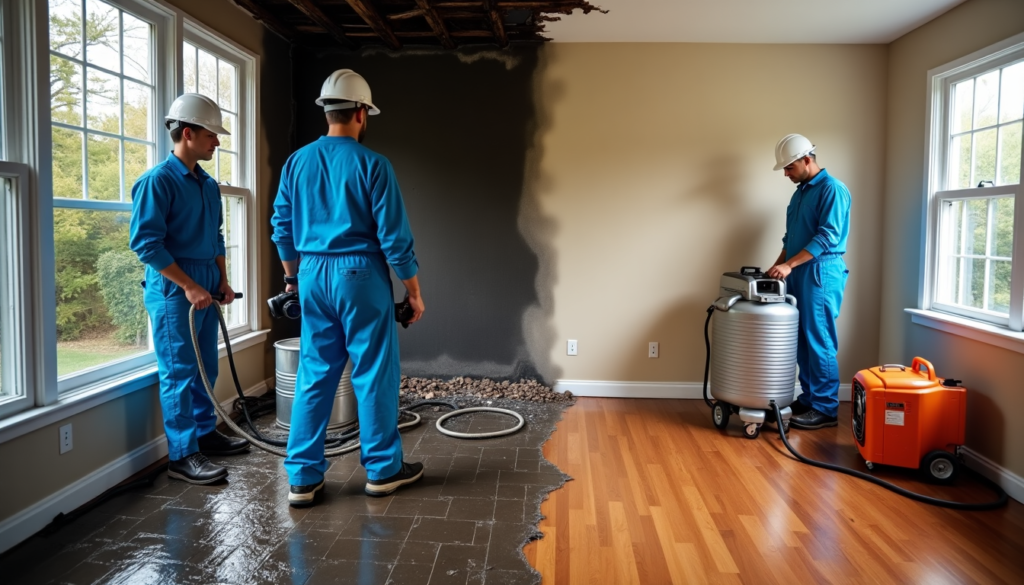
Mold can start growing in your property within just 24-48 hours after water damage. This fact surprises many property owners. Quick action becomes crucial after any property damage. Each hour of delay during fire or water damage restoration can worsen the situation and drive up repair costs.
Professional restoration services bring specialized equipment and techniques that most property owners can’t access. This makes the recovery process quicker and helps it work better. The right steps at the right time can mean the difference between a successful recovery and lasting property damage.
This piece guides you through each step to restore your property’s pre-damage condition. You’ll learn everything about the recovery process, from emergency response to final inspection.
Emergency Response: First 24 Hours
Quick action in the first moments after property damage can minimize losses and ensure safety. You should check if the property is safe to enter. Stay outside if you notice structural damage, exposed wires, or gas smells.
Immediate Safety Measures
Note that you need to turn off all utilities if safe. Check for electrical hazards, gas leaks, or compromised structural elements next. The main water supply should be shut off during water damage to prevent more flooding. Fire damage requires official clearance from firefighters before you can re-enter the property.
Damage Documentation Steps
A complete documentation helps with insurance claims. Here’s what you need to capture:
- Structural damage from multiple angles
- Personal belongings affected by the whole ordeal
- Pre-existing damage versus new damage
- Time-stamped photos and videos
Note that damaged items should be kept in a safe location until the insurance adjuster’s inspection. Keep all receipts for emergency repairs and temporary housing because these expenses are typically reimbursable.
Contacting Insurance and Restoration Services
Your insurance provider should be contacted right away to start the claims process. Give them a brief description of the damage and your current contact information. A professional restoration service can arrive within 60-90 minutes. Quick restoration prevents secondary damage like mold growth or structural weakening.
Understanding the Fire Damage Restoration Process
Fire damage restoration needs a step-by-step approach to fix both visible and hidden damage. The recovery process uses special cleaning techniques and structural reviews to make sure everything gets back to normal. Seeking professional fire clean up services ensures that each phase of the restoration process is handled efficiently and thoroughly, reducing the risk of lingering damage.
Smoke and Soot Removal Techniques
Soot particles create major health risks, especially when you have lung exposure through breathing or skin contact. The burned materials determine what kind of soot you’ll find:
- Wood and paper leave dry, ashy powder
- Plastic creates thick, sticky residue
- Grease and protein-rich foods make yellow-brown stains
Professional teams use specialized tools to clean up the mess. Their main focus stays on HEPA vacuum cleaners and commercial air scrubbers. They don’t start with water-based cleaners right away. Dry-cleaning sponges take care of surface residue first. On top of that, high-alkali detergents work best on oily soot from low-oxygen fires.
Structural Assessment Protocol
The full picture of structural damage comes after clearing out the debris. Engineers review load-bearing capabilities to check if structural parts still work. Their assessment looks for several key issues:
The review starts in the basement and works its way up. Engineers check for cracks in load-bearing walls, damaged support beams, and weak metal truss plates. These reviews help them figure out which structural parts need fixing or replacing.
Engineers use both destructive and non-destructive testing to review materials like concrete, wood, and steel. The fire’s temperature plays a crucial role because it shows how long materials were exposed and what happened to nearby components. These findings lead to a complete repair and restoration plan.
Managing Water Damage Recovery
A successful restoration process starts with quick water extraction. Professional restoration teams use specialized equipment to remove standing water and start the drying process.
Water Extraction and Drying Procedures
Professional restoration specialists remove water thoroughly with industrial-grade equipment. Powerful submersible pumps and truck-mounted vacuum units can extract hundreds of gallons of water. Moisture meters and infrared cameras help detect hidden water pockets behind walls or under floorboards.
The drying phase uses strategic placement of:
- Commercial-grade dehumidifiers
- Industrial air movers
- High-capacity fans
- Specialized drying systems
Restoration experts monitor humidity levels daily to ensure proper drying. The indoor humidity should stay between 40-60% to create a comfortable living space.
Mold Prevention Strategies
Mold grows faster than expected, often appearing within 24 to 48 hours after water exposure. Areas that look dry might still have hidden moisture in walls and flooring.
Restoration specialists prevent mold growth by:
- Removing wet materials that cannot be salvaged
- Applying antimicrobial solutions in affected areas
- Using HEPA vacuums and air scrubbers to sanitize spaces
Proper ventilation is a vital part of prevention. Air circulation improves when windows and doors are open, while dehumidifiers remove excess moisture from confined spaces. Small rooms like bathrooms need immediate attention because moisture tends to accumulate there.
Professional restoration teams use humidity sensors to monitor moisture levels throughout the process. This careful monitoring ensures complete drying and reduces future mold risks.
Professional vs DIY Restoration
Smart decisions about property restoration services start with a good look at your skills and the project’s complexity. We evaluated the choice between hiring professionals and DIY based on damage extent and safety risks.
When to Call Professionals
You’ll need professional help for big structural repairs, electrical system damage, or foundation problems. Restoration experts have specialized equipment and technical knowledge that most property owners can’t access.
You should call professionals for:
- Major structural damage to load-bearing walls
- Big water damage that might lead to mold
- Fire damage cleanup with smoke and soot
- Projects that need permits or must follow local rules
Safe DIY Recovery Steps
DIY restoration works well for small repairs you can handle. These usually include simple cleanup tasks and surface fixes. Take an honest look at your skills and get proper safety gear before you start any DIY work.
Small DIY projects still need good preparation. Local rules might require professional certification for certain repairs. Make sure you have the right tools and enough time to finish the project properly.
Cost-Benefit Analysis
Restoration costs go beyond your first expenses. A good tile cutter costs up to $3,000. This makes professional services more affordable for one-time jobs. Professionals also get better prices on materials and already own specialized equipment.
Look at these costs before deciding:
- Equipment rental or buying costs
- Time you’ll spend
- Risk of expensive mistakes
- What insurance requires
Professional restoration might look pricey at first but often saves money in the long run. Their expertise prevents more damage and gets the job done right the first time. This helps you avoid expensive fixes later.
Conclusion
In conclusion, navigating property restoration after damage can feel overwhelming, but with the right knowledge and timely action, recovery becomes more manageable. While some minor tasks can be handled as DIY projects, most restoration processes benefit from professional expertise to ensure safety, efficiency, and long-term results.
Whether you’re dealing with water damage, fire recovery, or mold prevention, choosing a reliable restoration service is an investment in your property’s future. Acting quickly and making informed decisions can save you time, money, and stress while protecting your most valuable asset—your home.
- 0shares
- Facebook0
- Pinterest0
- Twitter0



